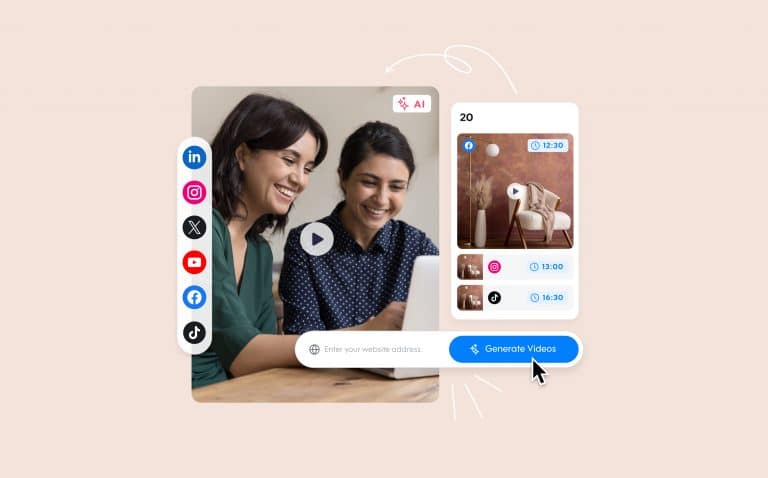
The Complete Guide to Real Estate Video Marketing
You likely have no shortage of real estate video marketing ideas.
Perhaps you’ve thought of a useful tip for prospective home buyers, a funny story your colleagues would enjoy, or an idea for a video that could drive your business. You’re not alone.
We’re seeing videos from the real estate industry everywhere—on Instagram, YouTube, LinkedIn, Facebook… you name it. And there’s a good reason for it—video marketing for real estate works.
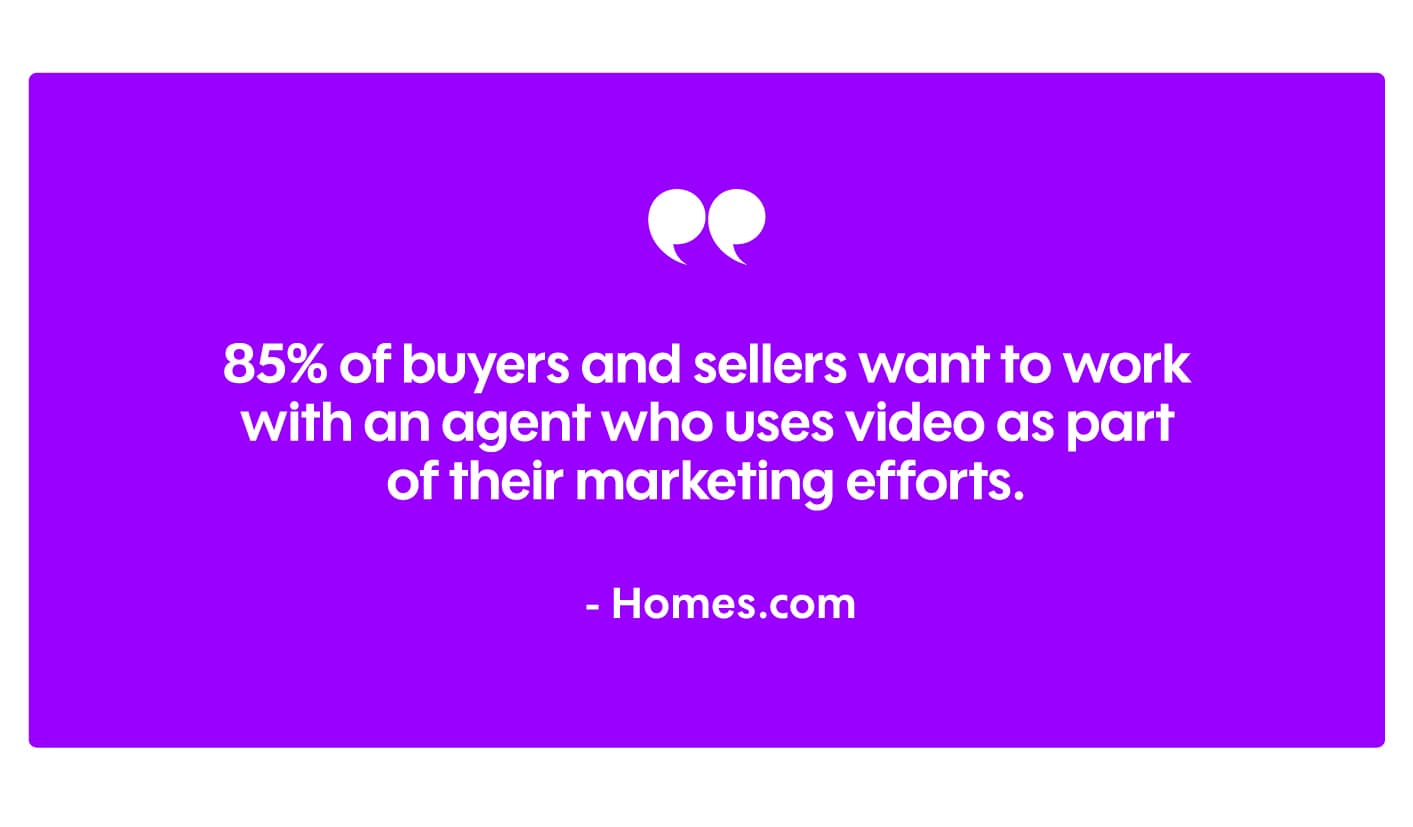
So if you’re a real estate agent or real estate agency, why haven’t you started executing on your video ideas? If you’re like many of the people we talk to, it’s due to one or more of the following reasons:
- Lack of expertise
- Lack of budget
- Lack of camera and/or technical equipment
- Not sure what to produce
- Not sure if it will work
- Not sure where to begin
- Don’t want to be on camera
Sound familiar? If any of these issues are preventing you from producing creative real estate videos, this guide is for you!
The purpose of this guide is to provide you with the knowledge, tools, and ability to create a video marketing plan—and produce actual videos—that will help you grow your real estate business.
This is a comprehensive guide to real estate video marketing, and while it’s beneficial to read from start to finish, you can use the table of contents to skip ahead to sections of particular interest.
Let’s rock.
Why video works
Video content is quickly becoming the new standard in real estate marketing.
This is a direct response to consumer demand:
- According to the National Association of Realtors, 36% of people use video as an information source during the home search.
- 85% of buyers and sellers prefer to work with an agent who uses video as part of their marketing efforts. (Homes.com)
To get specific, video marketing works because it’s able to fulfill consumer needs at two different stages—brand awareness and conversion.
Brand awareness
There are lots of agents who can help somebody buy or sell a house, so why would they choose you or your agency? The answer to that question is your brand.
Are you known for your expert knowledge of the neighborhoods you work in? Maintaining the best inventory? Something else? Creating brand awareness is absolutely essential in the real estate industry—Just think about all the outdoor media (bus stop benches, billboards, shopping cart hangers, etc.) that agents already buy that don’t showcase an actual listing.
When done correctly, video can be a highly effective and efficient medium for raising brand awareness. Imagine being able to add more than a headline to your billboard, such as a voice-over or proof of social engagement from clients.
For example, let’s say you’re trying to raise your personal profile in a specific market and you decide to publish an “About Me” piece of content. You’re going to use Facebook ads with a $100 budget to promote it.
Option 1 – Website traffic
You advertise on Facebook to send traffic to the About Me page of your website. The average cost-per-click (CPC) for Facebook ads in the real estate industry is $1.81. So for your $100 budget, you drove 55 people ($100 / $1.81 CPC) to your About Me page.
Option 2 – Video views
You create a short video (under 60 seconds) and advertise it on Facebook and Instagram. The average cost-per-view (CPV) for videos on Facebook ranges from .01¢ – .15¢, so we’ll use the high end. For the same $100 budget, 667 people ($100 / .15¢) will view your video. That is a 1,112% increase in the amount of exposure from page views for the same budget.
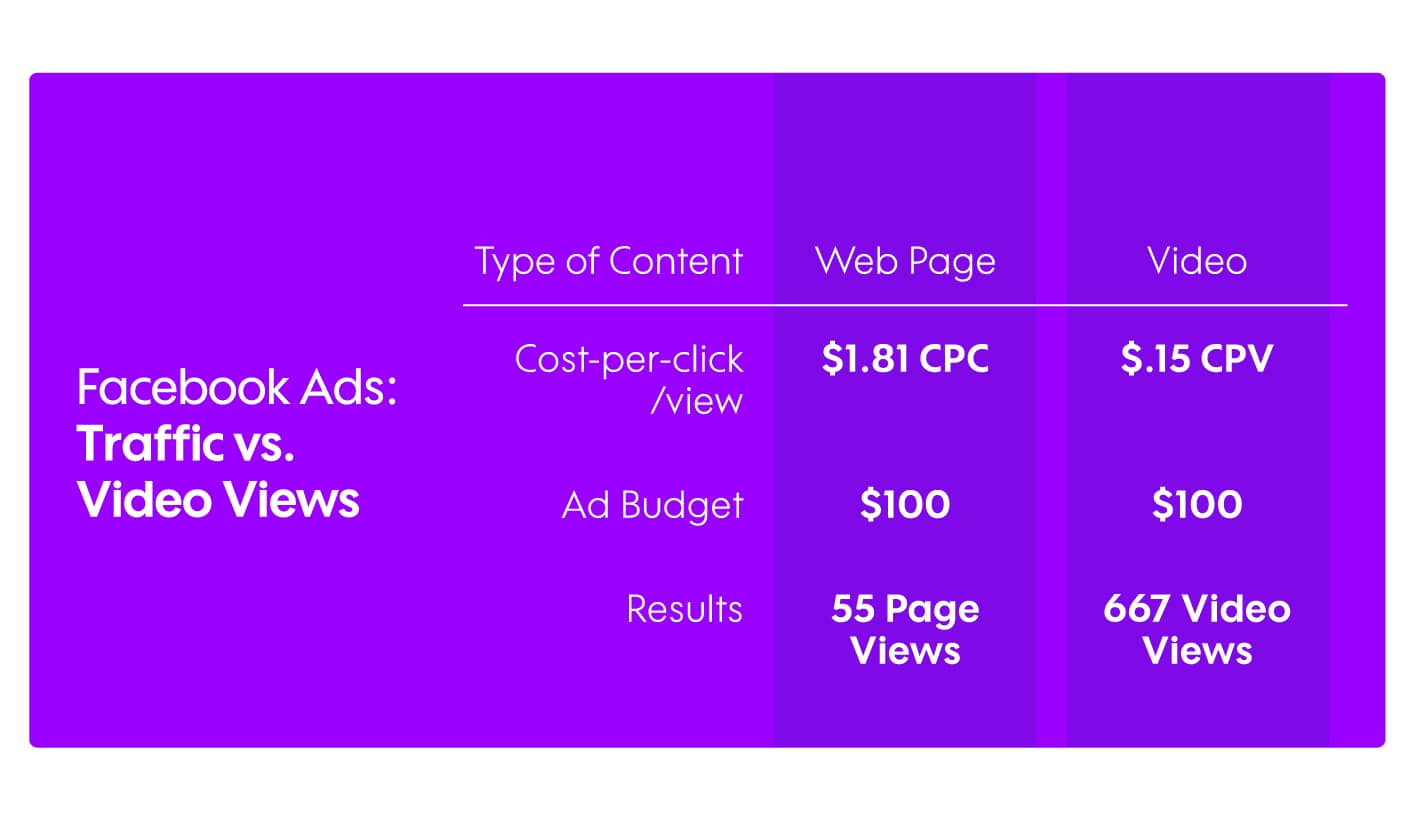
This example only speaks to the efficiency of using video. If you can raise more brand awareness with less budget, you can spend more on your closing activities like open houses. Additionally, with more brand awareness, conversion becomes easier because real estate leads come to you with a pre-existing favorable opinion of you. That’s the art and science of lead generation!
But there is also a case for effectiveness—video naturally provides a more conversational way to introduce yourself and your brand to an audience, and offers a lot more room for creativity.
For example:
- Are you good with interior design? Do a walk-through explaining how you might decorate.
- Do you have a good sense of humor? Tell a few jokes during your video.
Using video at the brand awareness stage of the potential buyers’ journey can help you stand out!
Increase sales/conversions
Let’s get right to the point:
Real estate listings with videos receive 403% more inquiries than those without video .
Additionally, videos provide a 74% increase in the understanding of your product, as well as increase the likelihood of purchasing your product by 64%. Note that this statistic is not specific to the real estate industry, but indicates a clear preference for consumers overall.
From the statistics alone there is an incredibly strong case for the ability of video marketing to increase conversions and sales.
By pairing different types of videos at different stages of the homebuyer journey you can grow your real estate business significantly. There’s more on what types of videos to use for each marketing goal later in this guide!
Challenges for real estate agents and agencies
The case for video marketing in real estate is compelling. But, that doesn’t mean video production and promotion don’t come without challenges. Let’s tackle a few of the primary objections together and see if we can get you started with video marketing!
Time for a little tough love…
1 – You don’t have the right equipment
We’re going to stop you right there and issue a hard truth: Your first several videos are NOT going to be good.
If you have limited experience being on camera, editing videos, content marketing, and copywriting, no amount of equipment is going to help you produce a polished video!
(Although with the Promo Editor, creating videos is easy, affordable and simple.)
Get your sub-par videos out of the way first, then upgrade your equipment as you get better at producing videos. Here is the list of bare-bones equipment that you can use to start creating a quality video:
- Smartphone
- Tripod
- Microphone
- Promo Editor
Lack of equipment is NOT an excuse to not create videos. Moving on.
2 – You don’t have a large budget
What did we just talk about? The equipment you need to get started is less than $50, and if you use Facebook and Instagram ads to promote your video, you can get more than 600 video views for $100.
Budget is not the issue. Next.
3 – You don’t like being on camera
This is a super common objection to producing video, yet completely erroneous. Apart from actors and news anchors, nobody likes to watch themselves on camera. But as we’ve already discussed, other people do! And being on camera increases your results.
Here’s something to keep in mind:
You interact with people every day—they trust you, they like you, and they buy from you. You’ve never lost a sale because you blinked weird.
When you’re on camera, act the same way as if you’re meeting with your favorite client.
4 – You’re not sure what to produce or where to begin
OK, we’ve finally reached a legitimate objection to why you haven’t started producing videos—you don’t have a plan.
“If you don’t know where you are going, you’ll end up someplace else.”
- Yogi Berra
Video marketing ideas for real estate agents are a dime a dozen, but an actual plan with actionable tactics is rare. A video marketing plan is the single most crippling obstacle for agents to overcome.
Lucky for you, we broke down the entire planning process.
Making a video marketing plan
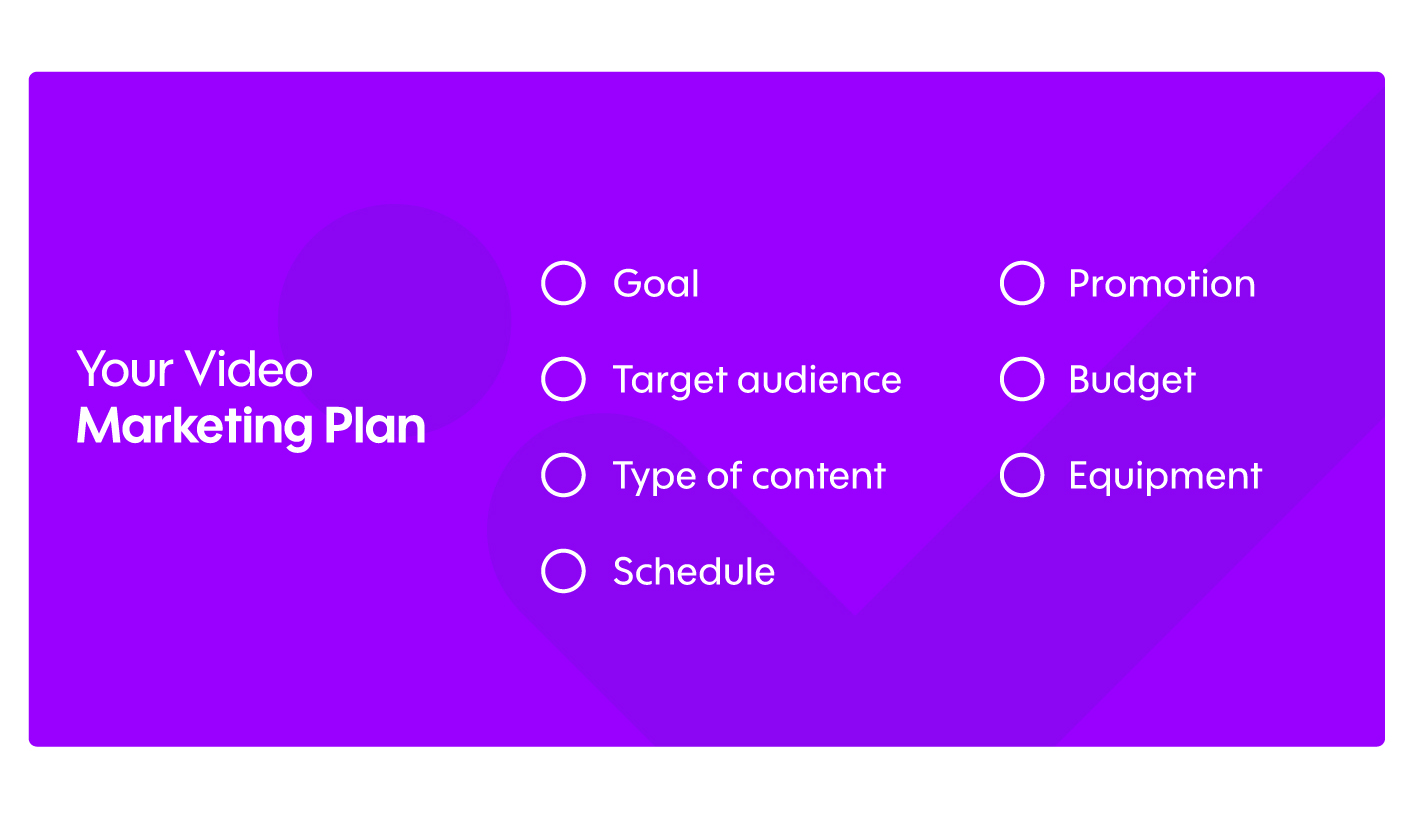
Success with video marketing is like going to the gym—if you don’t commit to a schedule and stick to it, you’ll end up on the couch watching reruns of The Office. But seriously, without a schedule, it just won’t work.
Remember these two key truths:
- Businesses should create lots of videos in order to succeed
- An investment in your marketing now can bring loyal customers for the entire year
Additionally, consider the logistics—There are different types of videos that require different content and production values. You can record a neighborhood tour video in an afternoon, but if you want to shoot a drone flyover video, you’ll need to schedule that ahead of time. You need a plan to juggle many different types of videos.
Luckily, creating a video marketing plan is not difficult.
If you know what type of budget you’ll need, what your target audience wants to see, and what types of videos to create, you can create a plan that really works, and one you’ll actually stick to.
Let’s break these down one at a time.
Budget
If you’ve been reading this guide and all the statistics included, you likely understand that video marketing should be your number one marketing priority. If you take a look at your current list of marketing activities and their associated costs, your budget for video should be at least whatever the top budget is.
But, we know it can be difficult to throw money at an unknown, so here’s a starter budget.
Note—you’ll want to adjust these figures, especially the real estate advertising and promotion suggestions, based on your clientele and market. The budget that works in West Texas may not get you as far in San Francisco.
You’ll need multiple videos to reach your goals (more on the different types of videos you’ll need and how to use them later in this guide), and each one will have separate production and promotional budgets.
As a video creation platform with a specific use case for real estate, we’d be remiss if we didn’t show you how you can use Promo.com to easily create stunning videos. Here’s a sample budget vs. a traditional video production budget:
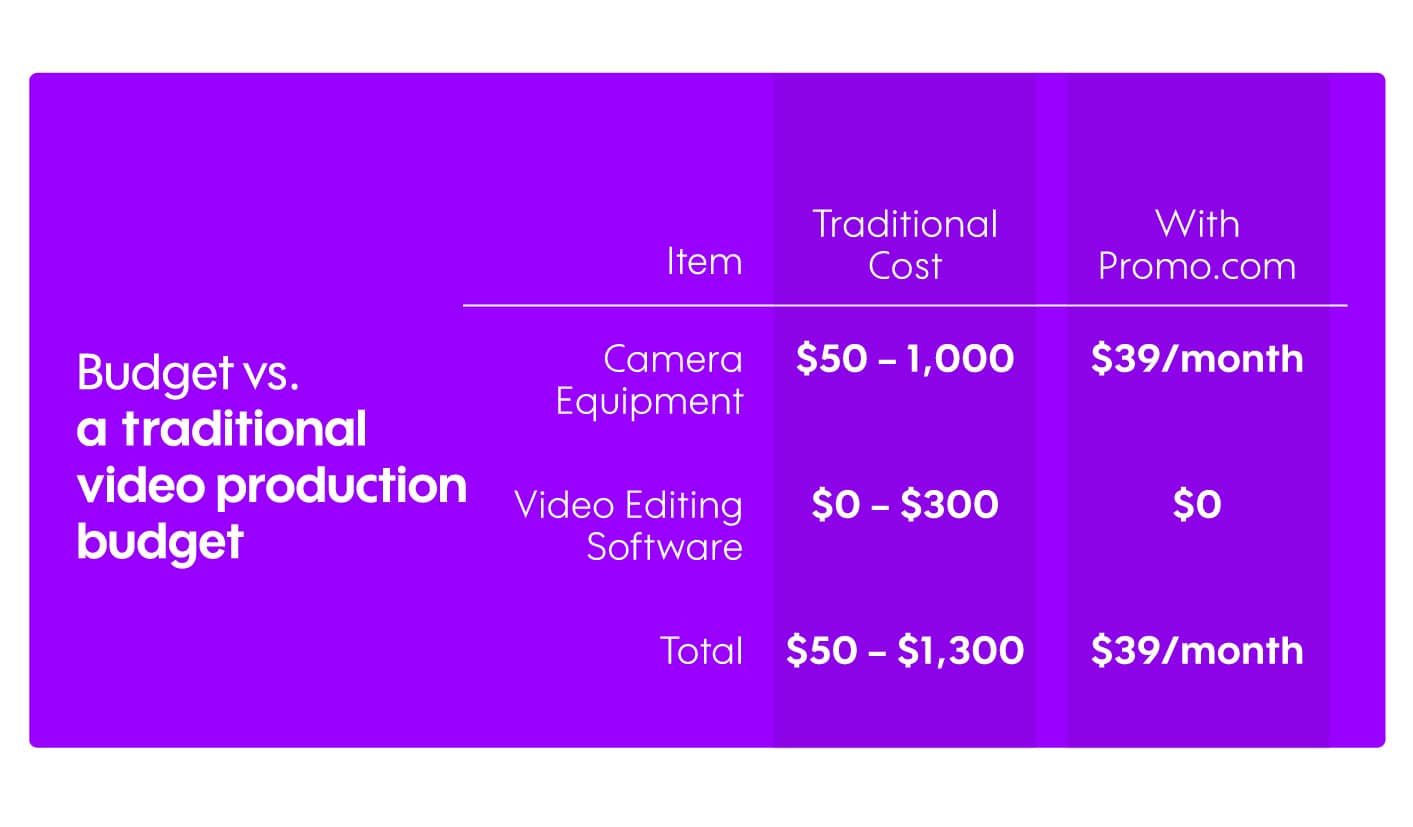
In total, using the Promo Editor and our library of more than 15 million video clips, you can create professional real estate marketing videos for a fraction of the cost of using traditional video production methods. Additionally, we offer collections of ready-made, customizable videos for real estate, so you don’t have to spend countless hours of your time learning how to use video editing software.
Here’s a sample budget if you’re just getting started with video marketing:
Budget for brand awareness videos
- Agent Profile Video
- Production: $500 – $2,000
- Promotion: $100
- Informational/How-To Video
- Production: $0
- Promotion: $300
Budget for conversion videos
- Listing Video
- Production: $0 – $1,000
- Promotion: $300
Total budget: $1,200 – $3,700
This is a very simple breakdown of the investment needed to get started with video. Your mileage may vary.
Target audience
If you deliver the ‘right’ message to the wrong audience, your videos might look great but they won’t get you the results you’re looking for. In fact, understanding your audience before you start creating videos is the key to making the process easy and effective.
Knowledge of your target audience helps you with planning your real estate video marketing in two ways:
- Determining what type of content to produce
- Determining where to distribute/promote that content
For instance, you wouldn’t include information about selling a home to an audience who’s looking to buy—those need to be separate videos, or else you risk half of the audience tuning you out halfway through the video.
Additionally, when it’s time to promote your video, the audience you’re targeting also determines the channel you use.
For example, you wouldn’t email your homebuyer prospect list with your latest video on preparing for a sale, but you might want to send that video to somebody you sold a house to 5 years ago.
See the power of planning with your target audience in mind?
As you’ve likely noticed by now, you need to have basic skills in three key areas in order to have success: video marketing, social media, and advertising.
We’ve actually covered all these on our blog before, so please feel free to check out additional for each:
- Video Marketing 101
- Social Media 101
- Facebook Advertising: The Complete Guide
- Or, search our blog for more topics!
Now, let’s move on to the different types of videos you’ll need to create.
Types of real estate videos
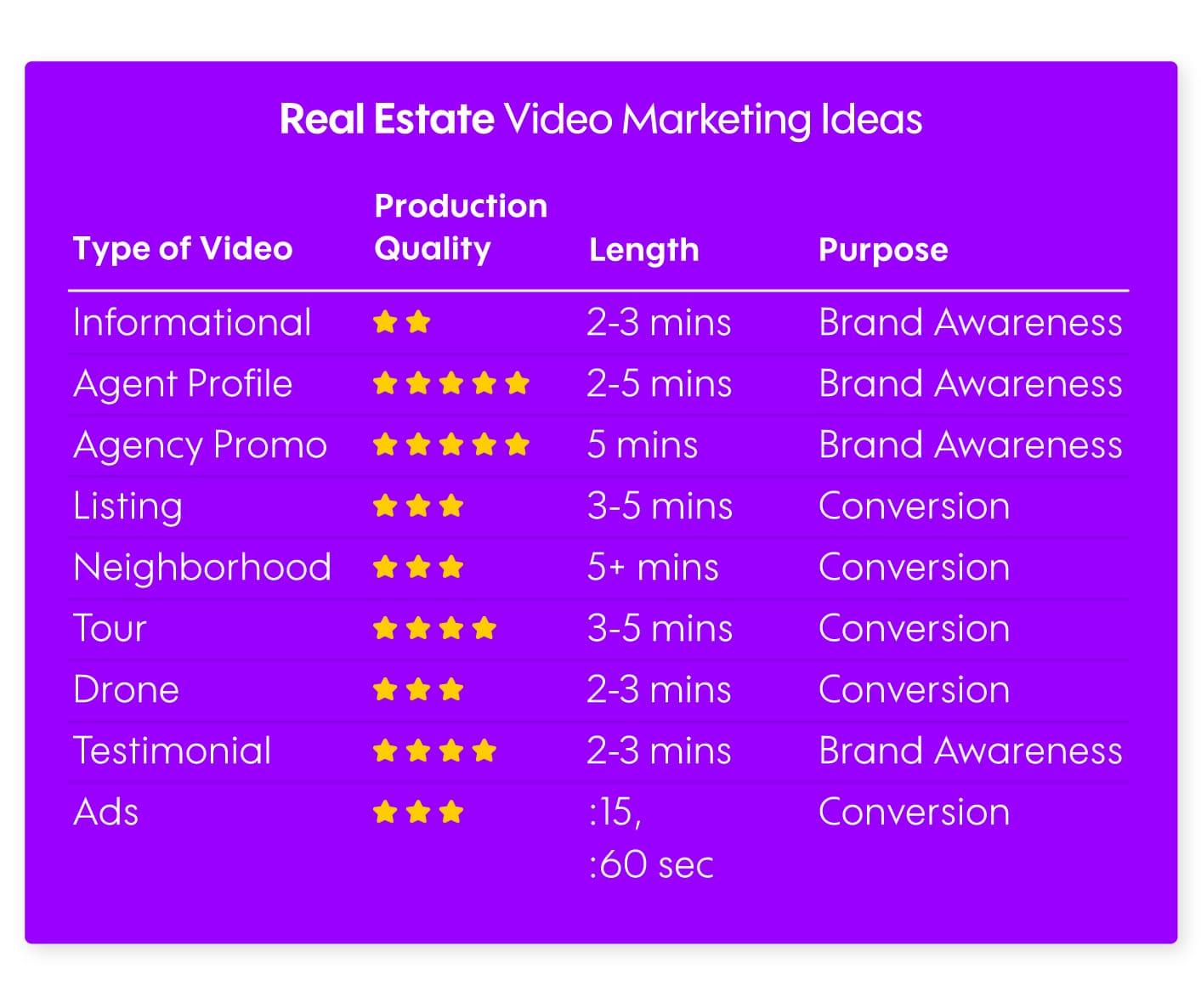
Now that you have an overview of video marketing for real estate, let’s dive into all of your available options. For each type of video, we’ve provided suggestions and details for:
- Content quality
- Production quality
- Promotion
Note—Lack of content quality can never be made up for by production value.
Informational/how-to videos
The Internet has made research so much easier for consumers. Have a question? Google it. This access to information has also raised consumer expectations—agents are now expected to provide valuable information (for free!) before a potential customer or seller would reach out. Therefore, providing value in the form of useful tips for prospective buyers or sellers is a great video to have in your library.
Suggested content:
What are you constantly asked by your clients? What are five things you wish every prospective home buyer knew? Here are some sample video topics:
- How to read an inspection report
- How to buy a bank-owned home
- How to choose a real estate agent
The best part about these videos is that you don’t even have to prepare much! You already know all this stuff, so just start recording.
Suggested production quality:
The bare minimum. The content of these types of videos is paramount, so as long as your audio quality is good, just start shooting with your mobile phone, tripod, and microphone.
Suggested promotion:
YouTube, Instagram Stories, organic social media, email to your list of prospects.
Note—For SEO purposes, limit your video to a single topic, and use the keyword of that topic in your video title and description on YouTube.
Agent profile videos
Real estate is a highly personal transaction. We have no doubt that once a buyer or seller gets to meet you, you’ll win them over, but how do you get them from internet research to first meeting, and at scale? With an agent profile video!
Suggested content:
Tell your potential clients why you do what you do; what gets you out of bed in the morning. Tell them about your past success with placing families and moving inventory.
Suggested production quality:
High. Put in the thought and effort to make this look professional—you only have one chance to make a first impression.
Suggested promotion:
Pinned to your social media profiles, in your email signature, YouTube, and website.
Agency promo videos
In addition to your agent profile video, your agency might want to invest in an agency promo video.
Suggested content:
All real estate agencies need a corporate brand video that describes the company, services, and people. You’ll definitely want to include a message from your leadership, about the company vision, and about what makes your agency different. It also doesn’t hurt to showcase your results and achievements. Go ahead and do a YouTube search for your competitors—there is no shortage of video marketing examples.
Suggested production quality:
High. You don’t want the appearance of an agency that’s not willing to spend money on high-quality work!
Suggested promotion:
Company website, company social media accounts, YouTube ads.
Listing videos
Arguably THE most important video an agent can make. The only thing that can give people a better idea of what a home is like than a listing video is to make an appointment to see the home in person, which is exactly what a listing video is designed to do.
Suggested content:
Pretty straightforward here, but show the darn house!
Here’s a step-by-step video guide to creating an awesome listing video with your smartphone.
Suggested production quality:
Medium to high. It is absolutely true that a low-quality video is better than NO video. But a video with poor audio, shaky camerawork, and poor lighting will decrease viewership. For some homes, it’s not economically feasible to hire a videographer to produce your video, and that’s OK. A few inexpensive mobile phone add-ons like a microphone and stabilizer (or app like Hyperlapse) can have dramatic effects on video quality.
Suggested promotion:
YouTube, organic social media, paid social media, email to your list of prospects.
Neighborhood videos

While listing videos are great, they don’t show off the neighborhood, which is a significant factor in a home purchase decision. Video provides the perfect medium to not only visually demonstrate what a neighborhood looks like, but talk about it in the form of a voice-over.
Bonus—if you have multiple homes in the same area, you can use a single neighborhood video again and again!
Suggested content:
Get up close and personal with the views, recreational areas, and amenities of the neighborhood. Don’t forget to tell the viewer what you know about the area and explain what types of families and or situations it’s ideal for.
Suggested production quality:
Medium to high. Because you can re-use this video multiple times, it’s worth it to invest in a professional video. Again, some sort of video is better than no video, but shooting video outside in a live environment presents some challenges to novice filmmakers.
Suggested promotion:
YouTube, organic social media, paid social media, email to your list of prospects.
Note—The neighborhood video can be used both as an attention-grabber promoted via advertising, and also a way to seal the deal for prospects who have already seen a listing video.
Video tours
A video tour is essentially a listing video that has higher production value and has a more comprehensive view of all of a home’s features. When done by a professional camera crew that specializes in creative real estate videos, the results can be stunning.
Suggested content:
The most important component of a video tour is that it covers all aspects of the house. Many are set to music as opposed to voice-over and can feel more like a branding experience than a detailed rundown of all the features of the house.
Suggested production quality:
High.
Suggested promotion:
YouTube, organic social media, paid social media, website placement.
Drone videos
Drone photography and videography are some of the best things to happen to real estate in recent years. An aerial perspective of the home and property provides a unique and eye-catching visual that can be used to attract attention and stand out. Drones have the capability to show off proximity, landscaping, and the neighborhood in a way that can’t be done from the ground. Additionally, you can use certain drones to fly through the house to provide a smooth tour experience.
Note—In order to fly drones for commercial use, you need to pass the FAA Airman Knowledge Exam under Part 107.
Suggested content:
This one’s pretty obvious, but get up high for an aerial shot! One technique is to start near ground level, then fly upward with the camera facing the property. Once the entire property has been shown from an aerial perspective, level out the camera to the horizon to showcase the area. You can also showcase high ceilings with drones.
Suggested production quality:
Medium to high. Drones with cameras are becoming increasingly affordable and easy to operate. With a little practice and some minor editing, even non-techie agents can produce eye-catching aerial shots of their inventory.
Suggested promotion:
YouTube, paid social media, organic social media.
Testimonial videos

Social proof is a huge factor in getting a prospective client to sign with you. Have you helped other people find their dream homes? Get them on camera telling everyone what a great job you did, what they liked about your service.
Suggested content:
Talking head videos (just people talking to the camera) work fine here, but if you can add in some b-roll of them enjoying their new home; even better! Additionally, you’ll want to include any key statistics from the sale that you are permitted to share, such as a quick closing window, selling above listed value, etc.
Suggested production quality:
Medium to high. We’re not saying testimonial videos can’t be done with a selfie camera, but generally, you want to put your best foot forward here.
Suggested promotion:
Your website, organic social media, paid social media.
Video ads
For the record, you can turn any one of the videos above into an ad with YouTube, Facebook, Instagram, LinkedIn, or Twitter. But, for videos that are designed to be ads from the beginning, we have one recommendation—keep them short. Under 60 seconds, and even as little as 15 seconds.
According to Facebook, “Shorter videos have higher completion rates, so you can successfully share your entire message.” There are certainly exceptions to this rule, but it’s a good idea to have at least one 15-second version for video ads.
Suggested content:
Seek to do one of three things in your real estate video advertising: educate, entertain, or inspire. Any of those three qualities help compel people to take action, such as filling out your interest form or starting a conversation. This means that many of the video types above (listing, informational, etc.) would make good ads.
Suggested production quality:
Medium. While most video advertisements tend to be more polished, there is a strong case being made for vertical videos in selfie mode on Facebook and Instagram Story ads. In fact, Buffer found that vertical videos on Facebook achieved 68% cheaper cost-per views than square videos!
Suggested promotion:
Facebook, Instagram, LinkedIn, Twitter, and YouTube.
After creating a real estate video ad on Promo.com you can publish it directly to your social networks. Try the same video on different channels and see which one performs best for you.
Speaking of performance…
Relevant video metrics/KPIs for real estate
You’re committed to putting some great real estate video out into the world—but what metrics should you look at to gauge success?
Before you start digging through your numbers on each social media and advertising platform, remember that there are two types of videos—brand awareness and conversion. Each has a different set of metrics that determine whether the campaign was successful or not.
Brand awareness metrics for video
- Cost-per-view (CPV): The amount you paid for a single view of your video
- Video watch percentage: How long somebody watched your video
- View count: How many total views your video received
- Feedback: Social engagement (Likes, Comments, Shares) on your video
Conversion metrics for video
- Cost-per-click (CPC): The amount you paid for somebody to click your call to action
- Click-thru-rate (CTR): The percentage of people who clicked your call to action out of everyone who watched
- Cost-per-acquisition (CPA): The amount you paid for somebody to become a lead
- Return on ad spend (ROAS): The amount of revenue directly attributed to your video ad budget
Advertising and video platforms track a lot more metrics than what’s listed above, but if you’re checking these on a regular basis, you’re in good shape.
Where to use and share real estate videos

Social Media
As we’ve hinted several times in this guide, social media is the perfect place to share the videos you’ve created. Social media is an especially great place to share brand awareness videos.
Each of the major social media platforms—Facebook, Twitter, LinkedIn, YouTube—is a good target for you to share your videos. As you begin to publish to each platform, however, make sure to check the performance of each video. Do certain types or lengths of videos do better on one platform or the other? Tailor your content marketing strategy based on that data.
Pro tip—Don’t post the same captions or text content with your video on all platforms. Use the unique characteristics of each platform to tailor your delivery.
For example, you only have 280 characters (including your link) on Twitter, so keep those messages short and to the point.
Facebook, however, allows you the ability to write longer text captions, so you could use that area to write a great description or mini blog post to supplement your video.
Depending on who you’re connected to on LinkedIn, it may be less appropriate to use lots of emojis in your captions.
Lastly, keep track of which videos perform well (view count, CTR, engagement) on each platform. Videos that perform well organically will generally make good ads, too! Test your videos organically before turning them into ads.
Website or Landing Pages
Beyond social media, your website and landing pages are both a great place to embed your videos.
According to Wordstream, adding video to your landing pages can increase conversions by 86%. Landing pages only have one purpose—to convert web visitors into new leads. With this in mind, make sure to choose videos from the conversion category, as opposed to brand awareness.
Your website, however, is a great spot for brand awareness videos. Agency sizzle reels, agent profile videos, and client testimonials are all great options for your website. Keep in mind that you’ll want to use videos that are higher production quality and evergreen for your website.
Offline Activities
Let’s get outside the box! As you get comfortable creating more types of videos, consider taking them offline as well.
Use the television screens at your next open house to play a video with interesting facts about the property.
Or, display some digital picture frames around the house with uploaded before/after videos.
Since you made it to the end of this guide, you’ve likely realized that getting started with video marketing is within your reach. We hope these suggestions, data, and resources help you get started growing your real estate business!
Ready to easily create real estate marketing videos? Get started with Promo.com for free today!
